For the 13½ years I’ve been in Buenos Aires, it’s been a given that if we wanted Korean food, we basically had to go to one of the two Koreatowns, in Flores or Floresta. Over the years, I’ve managed to get to almost all of the Korean spots in both areas – there are still a couple that I’ve not gotten to because of limited open hours, but eventually…. Outside of those areas, the options were, early on, Bi Won, hovering between Recoleta and Congreso; a very short-lived spot in Puerto Madero called Estilo Coreano that I never made it to; and later, in Chinatown, for Korean BBQ, the aptly named BBQ Town.
About two weeks ago I was alerted by one of our Horde members to the imminent opening of a new spot in the heart of Palermo, Namu, José Cabrera 5600, corner of Fitz Roy, taking over the spot abandoned by Roy Bar, a sort of dive craft beer bar (is that an oxymoron?) that offered up burgers and wraps.
Although I’m not overly fond of reviewing spots when they first open, as everyone needs time to get their act together, I thought I’d give it a try, and then decide whether to hold off and give them a couple of weeks, or go ahead. Obviously, I’ve decided to go ahead. Pretty room, with an interesting “garden” ceiling (I think it’s all plastic plants, but some of them look real, maybe it’s a mix?).
The menu is relatively short, with just five appetizers and eight main courses available. They do cover a nice range of different types of dishes. Of course, dumplings are my litmus test at most Asian restaurants, and the gun-mandu were delicate, flavorful, and cooked perfectly. Even with only five of them, they’re a far better deal at 170 pesos than last week’s round of eight mediocre ones for 180 pesos at the “fast food” Dumpling House.
Interestingly, unlike any other Korean restaurant I’ve been to, they don’t put banchan on the table at the beginning of the meal. They’re only served with the main courses, and, different dishes get a different number of (and presumably selection of) side dishes. I ordered up the daeji-bulgogi, spicy marinated pork, stir-fried, and served with rice. Again, unusual in the presentation, normally this would come with a side of lettuce leaves and some pickled vegetables to create wraps. But, it was absolutely delicious as is, I just missed that fresh crunch of the lettuce. 380 pesos.
I’d also asked for extra picante, and someone came out of the kitchen to let me know that because of the marinating process, it was a set level of spicy (pretty mild, as it turned out, despite the three chili symbol next to it on the menu), but they were happy to bring me a little side dish of gochujang chili paste to add to my tongue’s content. The banchan – very good, and nicely spicy kimchi, quite good pickled daikon, and just okay stewed eggplant and marinated tofu.
Overall, love the space, excellent service. Both dishes I tried were absolutely delicious. By comparison to either Koreatown, and for portions that are a bit smaller than you’d find out there, it’s a bit pricey, but for the heart of Palermo, it’s actually a quite reasonable meal for the quality. And, they take debit/credit cards (Visa only), something almost non-existent in either Koreatown. I will definitely be back for more! Highly recommended.
I was downtown last week and happened to pass by the corner of Esmeralda and M.T. Alvear, and spotted this sign for a soon to be opened (December 12) Korean spot, Fa Song Song, Esmeralda 993. Is this the start of a new trend? Will we (hopefully) start to see Korean spots opening in various parts of the city? Met up with one of our Horde members for lunch to check it out….
Mostly a business crowd, several Koreans having lunch. A lot of people wandered in while we were there and looked bewildered by the food. Each person entering was greeted with some variation of, “hi, we serve Korean food, do you know what that is?” Most didn’t, and most left after a brief introduction, especially the part noting that “pretty much everything is spicy”. I’d venture to guess… no, I’d bet, that 99% of locals have never actually eaten Korean food and have no idea that it’s different from Chinese or Japanese or any other Asian cuisine (things tend to get lumped together here and people get incensed when they can’t find sushi at a Thai place or sweet and sour chicken at a ramen bar).
The menu is short and sweet – three versions of deopbap – rice bowls – with either beef, pork, or salmon; two types of bibimbap – classic beef or vegetarian; four types of la-myeon (Korean style ramen) in egg, beef, shellfish, or sausage & kimchi, and two poke bowls, not a Korean dish, but both salmon, one made with wasabi mayo and one with wasabi soy.
Classic beef bibimbap, as good as I’ve had at pretty much any place in town. Only criticism would be that I’m used to the egg being pretty much raw when mixed in, or just barely poached, and letting it cook with the heat of the other ingredients – but I also usually order the dolsot bibimbap which comes in the hot stone bowl, that helps it do that. Reasonably spicy gochujang paste on the side to mix in.
The jeyuk deopbap was a nice, mildly spicy, heavily sesame sort of barbecued pork over rice. Very similar in many ways to the pork dish I had at Namu, above. Again, a touch of the chili paste gave it a heftier kick.
And, each main course is accompanied by a small bowl of kimchi, if you want – they ask, warning you it’s spicy if you’ve said you haven’t tried Korean food before. Really good kimchi too. This was the only banchan we were offered, not surprising given the style of food being served. But, it looked like they had small bowls of other things that weren’t spicy, like pickled vegetables, probably for the peole who say no to the kimchi.
Overall, nice casual space for lunch or early dinner (they’re open Monday through Friday from 11.30-3.00 and again from 6.30-9.30). Really good food. Very reasonably priced (280 and 250 pesos, respectively). Good selection of both soft drinks and beers, plus a variety of sojus (rice wines) from Korea. Highly recommended.
Return visit a couple of days later to try the haemul la-myeon, or seafood ramen in Korean. It was good, but less interesting than the other two dishes. It kind of felt like someone had taken a double batch of instant ramen and upgraded it with an egg, four small calamari rings, two small prawns, and some green onions. It was lacking in seafood, certainly, and the broth and noodles had that sort of packaged ramen flavor and texture – one of the biggest differences in an instant versus homemade broth is the lack of fat, oil, that is going to be part of the broth if it’s made from bones and meat, and this didn’t have any. As a fancied up instant style (or actual) ramen it was fine, but that’s about it. 250 pesos.
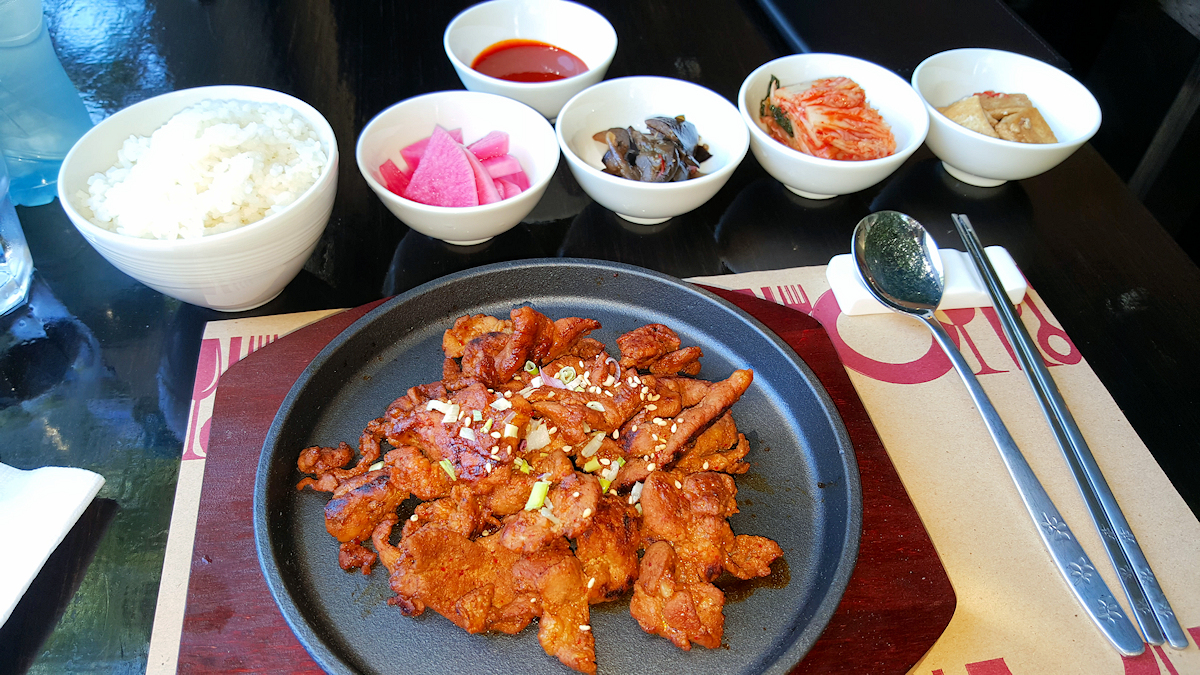
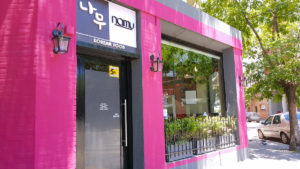
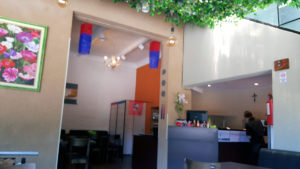
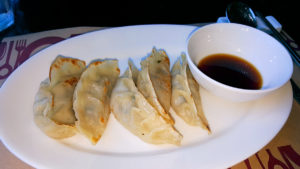
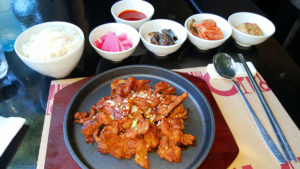
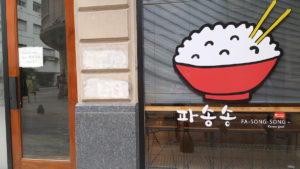
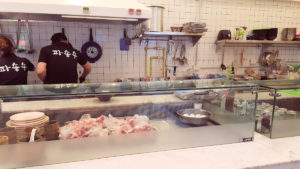
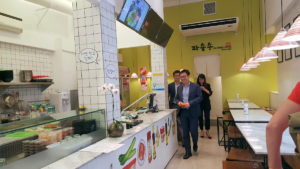
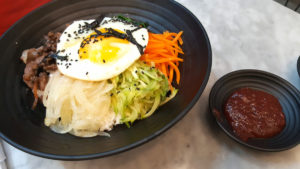
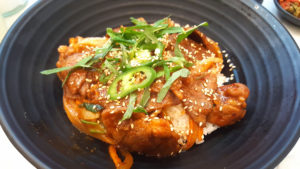
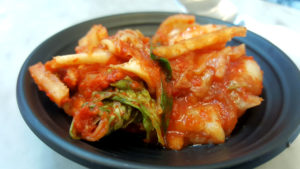
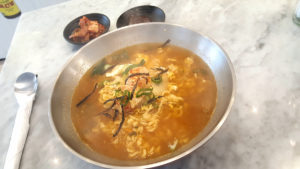
Thanks for the downtown recommendation. I will check it out.
Hope you like it, we were pretty impressed with the setup and the quality.
[…] one place or another – he’s the one who tipped me off to the imminent openings of Namu, the new Korean spot in Palermo, and Bronx Pizza here in Recoleta (the less about said, the […]
A couple of revisits to Namu when we didn’t feel like going out to Koreatown on a Sunday afternoon.
Kimchi-calamari pancakes… delicate, thin, crisp. Hmm… they’re tasty, but I’ve never seen Korean pancakes so thin and just kind of lacking in substance. I don’t know if it’s a style from some particular region, or if this is just a fancied up way of cost cutting, because at 150 pesos, they’re not cheap, and all four of them don’t add up to a quarter of the size of one you’d get in Koreatown for around the same price.
Japchae – an appetizer of sweet potato noodles with beef and egg and vegetables. Quite good, and even a reasonable portion for the 170 peso price tag.
A reasonably classic bibimbap with vegetables, beef, and egg. But back to being a pretty small portion for the 350 pesos it runs… then again, still Palermo.
Kimchi bocumbap – basically kimchi rice with a fried egg, and a bowl of soup on the side. A nice brunch dish, just not a lot of substance. 280 pesos.
And, gueranchim, basically scrambled eggs and prawns floating on vegetable soup, with rice on the side. A decent portion for 300 pesos, though there were few prawns, it was far more of an egg dish.
All told, in general, and mostly just in contrast to Koreatown restaurants, the portions are really small, and expensive. But, again, for Palermo, not out of line. The banchan are variable – one day the kimchi is spicy, another day it’s not, and the others vary similarly. But, we’ve liked everything we’ve tried. So all in all, especially as an alternative to trekking out to either of the Koreatowns, I recommend the place.
[…] Song Song, Esmeralda 993, Microcentro/Retiro. I reviewed this one when it first opened two years ago. At the time, they had a fairly limited menu that was mostly […]
A long awaited return to Namu, which I’d been to a couple of times pre-pandemic, and though higher priced than heading off to Koreatown, more convenient, and always delicious. Met up with a friend last weekend for a Sunday lunch. Oh… my. A pale shade of what it was a year and a half ago. I mean, I don’t want to bash restaurants in this post-pandemic reopening world, but the dumplings were still cold inside and had no seasoning to the filling. The sweet and sour prawns (a dubious dish in my book at any time, but my friend wanted to try them) were so sickly sweet and gloopy, and the coating on the prawns still semi-raw. And the chicken ssam, while reasonably tasty, was missing all the good stuff like herbs and fresh slivers of vegetable to wrap in the lettuce leaves, as well as the latter being cut up into small squares, barely big enough to wrap anything. Overall, very disappointing, and these three dishes plus a water and a soda, plus tip, came in at 3000 pesos.
[…] the other hand, a delivery order from a long time fave, Fa Song Song, also in Microcentro, at Esmeralda 993, of steamed and fried dumplings, and a bulgogi kimbap was a […]